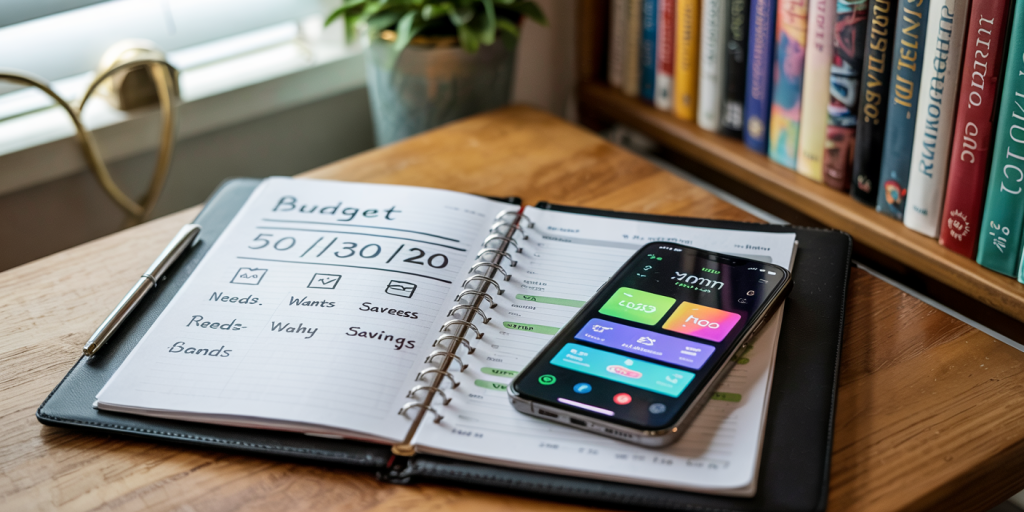How to Build a Financial Routine That Supports Your Goals
In today’s fast-paced world, managing personal finances efficiently has become more critical than ever. A well-structured financial routine not only helps maintain financial stability but also propels you toward achieving your long-term and short-term goals. Whether your objectives include buying a home, saving for retirement, or building an emergency fund, establishing a consistent financial routine sets the foundation for success.

According to a 2023 survey by the National Endowment for Financial Education (NEFE), only 33% of Americans follow a consistent budgeting or financial management routine. This statistic highlights the widespread challenge of managing finances systematically. However, by creating a personalized financial routine tailored to your goals, you can improve financial discipline, reduce stress, and build wealth over time. The following sections explore the steps and strategies needed to develop and maintain an effective financial routine that supports your ambitions.
Understanding Your Financial Goals Clearly
Before you can build a financial routine that works, it’s essential to define your financial goals. This process involves specifying what you want to achieve, the timeline for these achievements, and the priority of each goal. Financial goals typically fall into three categories: short-term (1-3 years), medium-term (3-7 years), and long-term (7+ years). Examples include paying off credit card debt, saving for a child’s education, or planning for retirement.
For instance, Sarah, a 28-year-old graphic designer, identified paying off her $10,000 student loan in three years as her short-term goal, while saving for a down payment on a house in seven years was medium-term. By categorizing her goals, she was able to allocate resources accordingly and create a step-by-step financial plan. Defining clear goals prevents distractions and helps focus your financial routine on what matters most.
Comparatively, those who fail to set specific targets often struggle with inconsistent saving habits and overspending. According to a Fidelity study in 2022, individuals with clearly defined financial goals are 42% more likely to save consistently and 50% more likely to avoid debt accumulation. By fully understanding your goals, you set the stage for disciplined money management.
Designing a Budget that Aligns with Your Objectives
Once your financial goals are clear, the next step is creating a budget that aligns with those objectives. A budget acts as a financial roadmap, guiding your income allocation toward expenses, savings, and investments. There are various budgeting methods such as zero-based budgeting, the 50/30/20 rule, and envelope budgeting, each with pros and cons.
For example, the 50/30/20 rule divides your income into 50% for needs, 30% for wants, and 20% for savings and debt repayment. John, a 35-year-old teacher aiming to build an emergency fund of $15,000, found this simple method effective because it balanced spending freedoms with savings discipline. He allocated 20% of his $4000 monthly income strictly toward savings, allowing him to reach his emergency fund target within two years.
Comparison Table: Popular Budgeting Methods
| Budgeting Method | Description | Best Suited For | Downsides |
|---|---|---|---|
| Zero-Based Budgeting | Assigns every dollar a job | Detailed planners | Time-consuming to maintain |
| 50/30/20 Rule | Income split into needs/wants/savings | Beginners and moderate spenders | Less precise in complex finances |
| Envelope System | Physical envelopes for spending | Cash users and impulse controls | Less convenient with digital payments |
Implementing a budget requires discipline and regular tracking. Tools like Mint, YNAB (You Need A Budget), or even spreadsheet software can help efficiently manage your budget. Incorporate regular intervals, such as weekly or monthly reviews, to assess adherence, identify leaks, and adjust allocations to better serve your financial goals.

Statistics show that those who track their expenses regularly are 30% more likely to improve savings rates and reduce unnecessary expenditures. By designing a budget that reflects your goals, you create a practical framework for financial growth and control.
Automating Savings and Payments for Consistency
Automating your finances is a powerful strategy to ensure that your financial routine is consistent and sustainable. By setting up automatic transfers to savings accounts, investment portfolios, or debt repayments, you remove the emotional decision-making barrier that often hampers regular saving.

Consider the case of Michael, a 40-year-old marketing professional who struggled to save despite a stable job. After automating his savings to transfer 15% of his paycheck directly into a high-yield savings account, he noticed a steady increase in his emergency fund and retirement accounts without feeling deprived monthly. Automation also minimizes late payment fees and negative impacts on your credit score by scheduling bill payments on due dates.
According to a report by the Consumer Financial Protection Bureau (CFPB), automated savings plans increase saving rates by up to 81% and contribute significantly to debt reduction. Setting up automation can be done easily through most banks and financial institutions. Prioritize automating high-impact financial activities like debt payments to avoid compounding interest and savings contributions to benefit from the power of compounding returns.
Regularly Reviewing and Adjusting Your Financial Plan
Building a financial routine isn’t a one-time event but a dynamic process that requires regular reviews and adjustments. Life circumstances, market conditions, and your financial goals can change, making it crucial to reassess and realign your financial actions regularly.
Quarterly or biannual financial reviews can involve evaluating income changes, expense patterns, savings progress, and investment portfolio performance. Emma, a small business owner, conducts quarterly reviews to evaluate her cash flow and adjust spending post-business fluctuations. She also reassesses her retirement contributions annually, ensuring that her plans have adapted alongside her income growth.
Failing to review and update your financial routine can lead to missed opportunities or financial stagnation. For example, ignoring changes in interest rates on loans or investment returns may cause suboptimal financial decisions. Data from Vanguard’s 2023 Investor Study shows that investors who review their portfolios at least twice a year achieve returns 15% higher on average than those who invest passively without review.
Regular reviews also empower you to celebrate milestones and recalibrate if certain goals become less relevant or more urgent. This ongoing process ensures your financial routine remains relevant, focused, and motivated by tangible progress.
Incorporating Debt Management and Credit Health into Your Routine
A robust financial routine must include managing existing debt prudently and maintaining good credit health. High-interest debt such as credit cards or payday loans can derail your financial goals if left unchecked. Incorporating strategies to reduce and eventually eliminate debt ensures more funds are freed up for savings and investments.
Take the example of Luis, who accumulated about $20,000 in credit card debt over a few years. By structuring his routine to pay off the debt using the debt snowball method—where he targeted the smallest debt first then moved to larger ones—he maintained motivation and saw his debt decrease steadily. Alongside, he kept track of his credit score monthly via free tools like Credit Karma, which improved from 620 to 750 within two years.
Maintaining good credit health is not only about reducing debt but also involves timely payments, managing credit utilization ratios, and limiting new credit inquiries. Credit reporting agencies like Experian state that a strong credit score can reduce borrowing costs by up to 20%, translating into significant savings over time.
Incorporating debt management into your online banking alerts or personal finance apps can prompt timely payments and alerts. Integrating these practices into your weekly or monthly routine ensures that debt does not derail financial progress.
Embracing Future Perspectives: Technology and Financial Wellness Trends
The future of personal finance management lies in embracing technological innovations and holistic wellness approaches. Emerging technologies such as Artificial Intelligence (AI) driven financial advisors, blockchain for transparent transactions, and personalized financial apps are transforming how routines are built and sustained.
For example, AI tools like Cleo or Albert analyze your spending patterns and provide tailored saving tips, helping automate more personalized financial routines. Moreover, the rise of “financial wellness” programs in workplaces prioritizes financial education, emotional support, and practical tools, recognizing that financial health impacts overall wellbeing.
Looking ahead, integrating financial routines with lifestyle changes such as mindful spending, sustainable investing, and income diversification will become standard. Adopting a financial routine now that is adaptive to these evolving tools and mindset shifts will position you to maximize your financial success in the coming decades.
According to a 2024 Accenture report, 68% of millennials and Gen Z are more likely to adopt fintech solutions that promote automated, goal-oriented financial planning. The continued growth and accessibility of such solutions promise higher engagement and better financial outcomes for users willing to maintain disciplined routines.
Building a financial routine tailored to your unique goals involves a series of thoughtful steps: defining clear objectives, designing a supportive budget, automating processes, reviewing regularly, managing debt efficiently, and embracing future trends. Each element contributes to a sustainable process that boosts confidence and control over your financial life. By committing to such a routine, you pave the way for financial independence and the realization of your dreams.

Hi, this is a comment.
To get started with moderating, editing, and deleting comments, please visit the Comments screen in the dashboard.
Commenter avatars come from Gravatar.